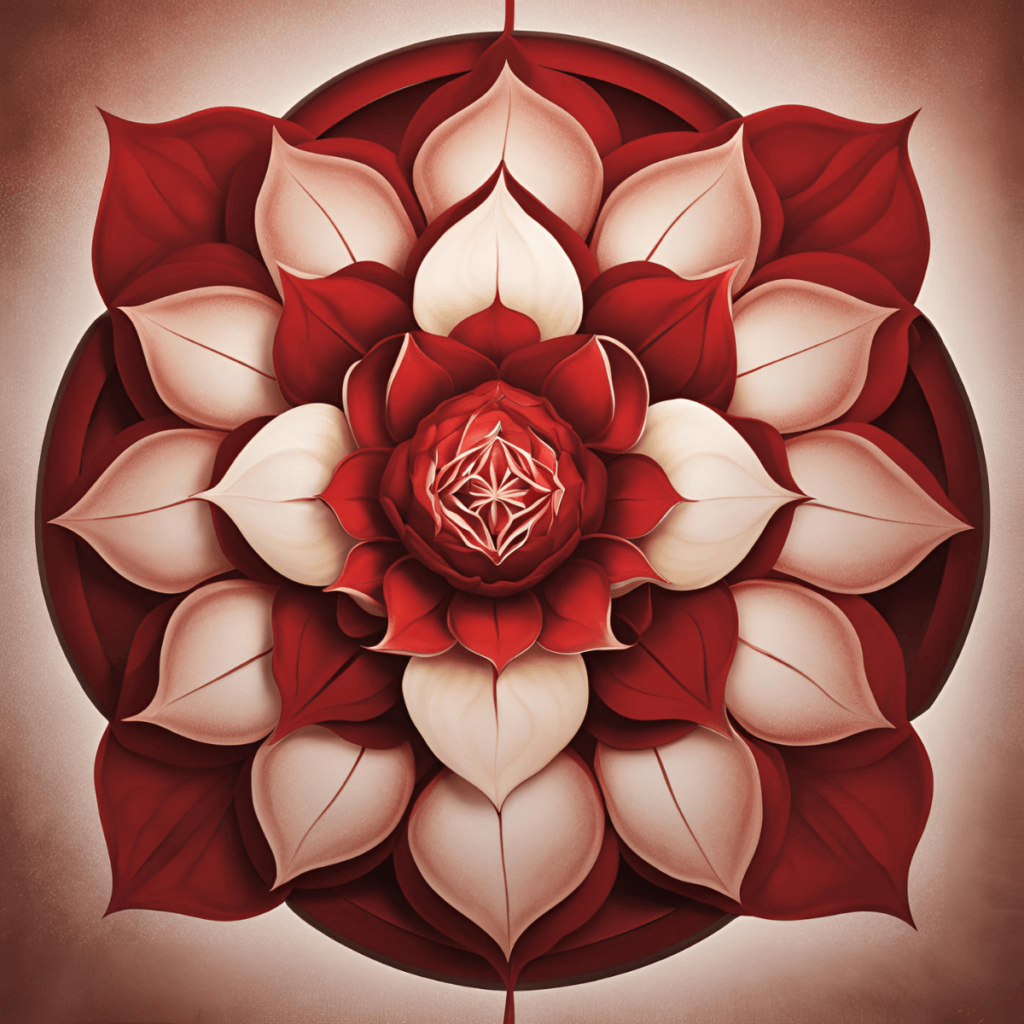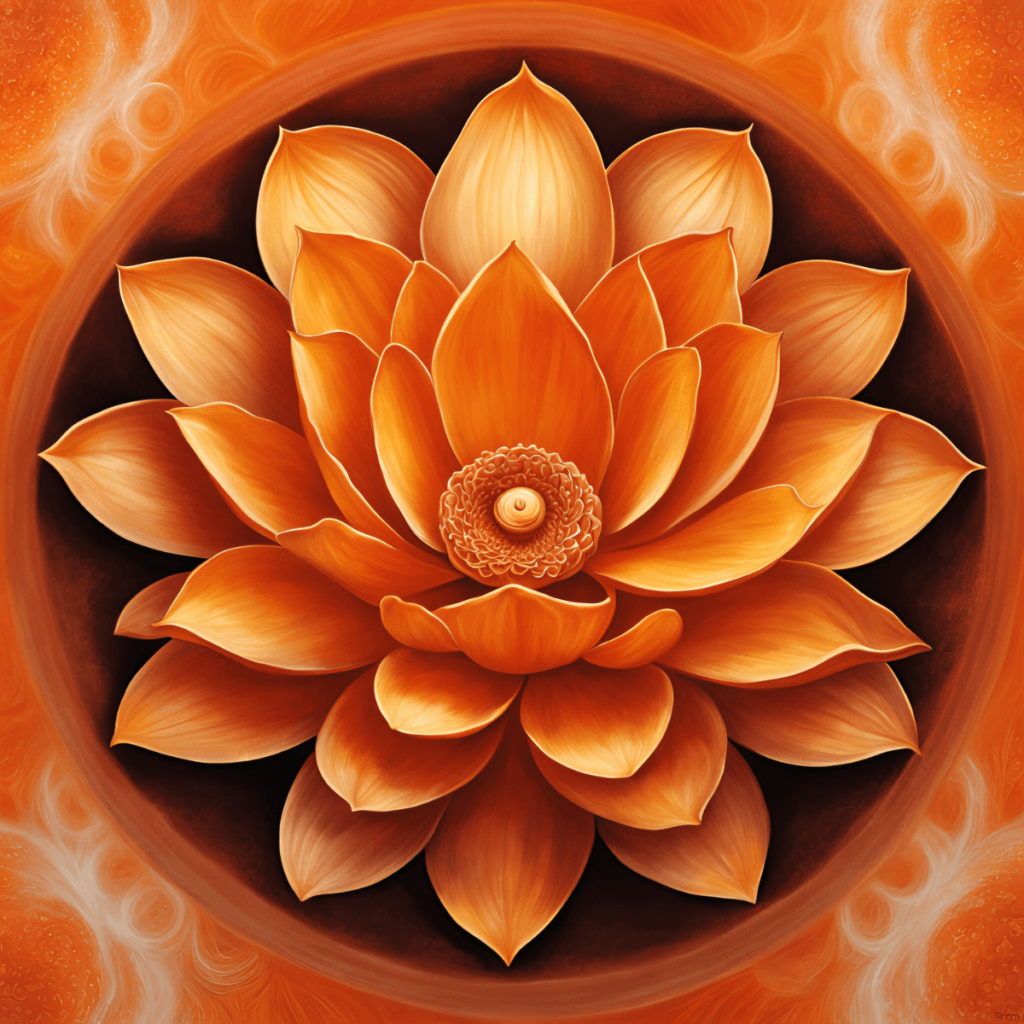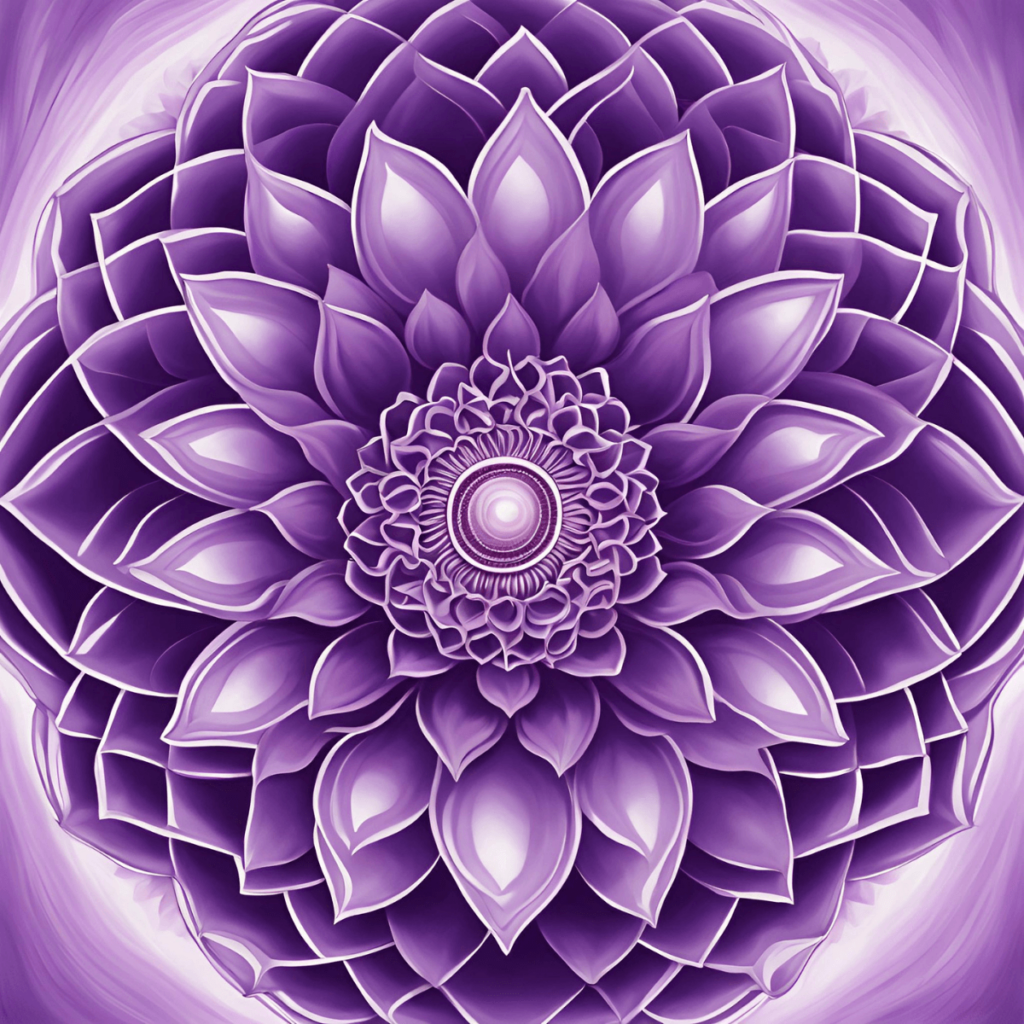
The Root Chakra
The Root Chakra, known as Muladhara in Sanskrit, is the bedrock of our energy system, nestled at the base of the spine between the anus and genitals. It serves as our vital connection to the physical realm, embodying themes of survival, stability, and our most primal instincts, symbolized by the color red and the grounding element of earth.
Its primary function is to anchor us firmly to the earth, providing a sense of security and rootedness. Governing fundamental needs such as food, shelter, and safety, the balanced Muladhara Chakra instills confidence and a profound sense of belonging in the world.
Imbalances in this chakra can manifest physically through issues like lower back pain, immune system disorders, and ailments in the legs and feet. Emotionally, it may evoke feelings of fear, insecurity, and instability, often accompanied by restlessness and anxiety, profoundly impacting overall well-being.
To foster equilibrium in the Root Chakra, several practices prove invaluable. Grounding exercises, like barefoot walks on natural terrain or immersing oneself in nature, forge a direct connection with the earth’s nurturing energies. Meditation techniques centered on visualizing a vibrant red light at the base of the spine can effectively restore balance. Physical activities such as yoga, especially postures like Mountain Pose (Tadasana) and Tree Pose (Vrikshasana), strengthen this connection to the earth element.
Harnessing the potency of crystals such as Red Jasper and Hematite amplifies grounding efforts, harmonizing with the Root Chakra’s frequency to stabilize its energy flow. Aromatherapy, employing essences like patchouli and cedarwood, complements this process, promoting a deep-seated sense of security and stability.
In meditation, intoning the seed mantra “LAM” resonates profoundly with the Root Chakra, fostering alignment and coherence. Affirmations such as “I am grounded and secure” reinforce feelings of stability, vital for sustaining a balanced Muladhara Chakra.
By nurturing the Muladhara Chakra, we lay a firm foundation for physical and emotional well-being, enabling us to navigate life with assuredness and resilience. This grounding essence facilitates the unimpeded flow of prana, the life force energy, throughout the entire chakra system, nurturing overall harmony and equilibrium within body and mind.

The Sacral Chakra
The Sacral Chakra, known as Svadhisthana in Sanskrit, resides just below the navel in the lower abdomen, serving as a pivotal energy center that influences emotional, creative, and sexual energies. As the second primary chakra, its impact extends beyond the physical realm into emotional and spiritual well-being.
Location and Physical Influence: Physically, the Sacral Chakra governs the reproductive organs, bladder, and lower back. It plays a crucial role in our ability to experience pleasure and enjoy sensual experiences. A balanced Svadhisthana supports optimal functioning of these organs, promoting vitality and overall well-being. Imbalances may manifest as sexual dysfunction, lower back pain, or urinary issues.
Emotional and Creative Expression: Emotionally, Svadhisthana is intricately linked to our feelings and how we express them. It facilitates intimacy, passion, and creativity, nurturing healthy relationships and emotional resilience. A harmonized Sacral Chakra empowers individuals to embrace change with grace and explore their creative potential through artistry, innovation, or problem-solving.
Color and Element: Orange is the color associated with the Sacral Chakra, symbolizing warmth, creativity, and enthusiasm. It ignites passion and creativity, infusing life with joy and vitality. Water is its corresponding element, embodying fluidity, adaptability, and the capacity to navigate life’s ebbs and flows. Water also signifies emotional cleansing and purification, vital for maintaining equilibrium within this chakra.
Balancing and Healing: To cultivate or restore balance in the Sacral Chakra, several practices are beneficial:
Meditation and Visualization: Visualize a vibrant, spinning orange wheel at the sacral area during meditation to activate and harmonize this chakra.
Movement and Dance: Engage in fluid, expressive movements such as dance or specific yoga poses that focus on the pelvis and lower abdomen to release blockages and stimulate energy flow.
Emotional Release: Utilize journaling, therapy, or artistic expression to process and release stored emotions, fostering emotional clarity and healing.
Creativity: Participate in creative endeavors like painting, writing, or music to amplify the flow of creative energy through the Sacral Chakra, enriching personal expression and fulfillment.
By nurturing the Sacral Chakra, individuals can deepen emotional intelligence, strengthen interpersonal connections, and unlock their innate creative capacities. This fosters a harmonious and balanced life, enriched by emotional fulfillment and creative exploration.

The Solar Plexus Chakra
The Solar Plexus Chakra, known as Manipura in Sanskrit, is a potent energy center located just above the navel in the abdominal region. It holds profound influence over personal power, self-esteem, confidence, and the ability to assert control over one’s life circumstances. As the third primary chakra, Manipura governs essential psychological and physiological functions that underpin assertiveness and self-assurance.
Location and Physical Influence: Physically, the Solar Plexus Chakra oversees the digestive system, including vital organs such as the stomach, liver, gallbladder, pancreas, and adrenal glands. It plays a pivotal role in metabolic processes and regulates energy levels throughout the body. A balanced Manipura Chakra fosters vitality, optimal digestion, and overall physical well-being. Imbalances may manifest as digestive disorders, eating issues, or challenges related to self-perception.
Personal Power and Confidence: Manipura Chakra is intricately linked with personal power, confidence, and self-esteem. It empowers individuals to assert themselves, establish healthy boundaries, and pursue goals with unwavering determination. A harmonized Solar Plexus Chakra nurtures a robust sense of self-worth, inner strength, and accountability for one’s actions and decisions. It enables individuals to confront challenges with resilience and courage, maintaining clarity of purpose and direction in life.
Color and Element: Vibrant yellow is the color associated with the Solar Plexus Chakra, symbolizing intellect, optimism, and clarity of thought. Yellow hues stimulate mental agility and decisiveness, encouraging individuals to embrace their personal power and pursue aspirations with enthusiasm. Fire is the element corresponding to Manipura, embodying transformation, passion, and the inner drive to achieve. Fire symbolizes the energy essential for personal growth, transformation, and the manifestation of dreams and ambitions.
Balancing and Healing: Maintaining equilibrium in the Solar Plexus Chakra is pivotal for overall well-being and personal empowerment. Effective practices to support Manipura include:
Breathwork and Meditation: Engaging in deep breathing exercises and meditation techniques that focus on the Solar Plexus area can invigorate energy flow and restore balance.
Core Strengthening Exercises: Physical activities like yoga poses, Pilates, or martial arts that engage the abdominal muscles can strengthen the Solar Plexus Chakra, fostering physical and energetic resilience.
Self-Reflection: Journaling and introspective practices that explore personal strengths, values, and aspirations enhance self-awareness and bolster self-confidence.
Setting Boundaries: Learning to assert healthy boundaries in relationships and situations promotes self-respect and personal empowerment.
Visualization: Envisioning a radiant yellow sun or a dynamic, spinning wheel of yellow light at the Solar Plexus can activate and energize this chakra, promoting vitality and assertiveness.
By nurturing the Solar Plexus Chakra, individuals cultivate a deep-seated sense of self-confidence, assertiveness, and personal empowerment. This foundation enables them to navigate life’s complexities with resilience, authenticity, and a steadfast sense of purpose.

The Heart Chakra
The Heart Chakra, known as Anahata in Sanskrit, is a profound energy center situated at the center of the chest, near the heart. It acts as a bridge between the physical and spiritual realms, facilitating the expression and experience of love, compassion, and interconnectedness with oneself and others. As the fourth primary chakra, Anahata exerts significant influence over emotional well-being, relationships, and the capacity to give and receive love unconditionally.
Location and Physical Influence: Physically, the Heart Chakra governs crucial organs such as the heart, lungs, circulatory system, and thymus gland. It plays a vital role in the circulation of blood and the immune response, reflecting its role in nurturing and sustaining life. When in balance, individuals experience optimal heart health, emotional stability, and a profound sense of inner peace. Imbalances may manifest as respiratory ailments, heart conditions, or challenges in forming meaningful connections with others.
Love and Compassion: Anahata Chakra is intimately linked with love in its purest forms: self-love, romantic love, familial love, and unconditional compassion for all beings. It empowers individuals to open their hearts, heal past wounds, and embrace compassion for oneself and others. A balanced Heart Chakra nurtures empathy, kindness, and the ability to cultivate harmonious relationships built on mutual respect and understanding. It encourages authenticity and the free expression of emotions, fostering deep emotional fulfillment and connection with others.
Color and Element: The color associated with the Heart Chakra is lush green, symbolizing growth, renewal, and harmony. Green hues promote balance and healing, encouraging individuals to infuse love and compassion into their interactions with the world. Air is the element corresponding to Anahata, representing freedom, expansion, and the breath of life. Air signifies the capacity to transcend challenges, gain perspective, and embrace love as a unifying force that transcends boundaries and differences.
Balancing and Healing: Maintaining equilibrium in the Heart Chakra is essential for emotional well-being and the cultivation of loving relationships. Effective practices to support Anahata’s health include:
Heart-Centered Meditation: Techniques that focus on the heart area, such as loving-kindness meditation or visualizing a radiant green light at the chest’s center, can promote healing and restore balance.
Practicing Forgiveness: Releasing resentments and practicing forgiveness, both towards oneself and others, fosters emotional healing and opens the heart to love.
Acts of Kindness: Engaging in acts of compassion and service to others deepens empathy and fosters a sense of connection.
Nature Connection: Spending time surrounded by greenery in nature harmonizes and rejuvenates the Heart Chakra.
Heart-Opening Yoga Poses: Practices like backbends or heart-opening yoga poses stretch and open the chest area, releasing tension and stimulating energy flow through the Heart Chakra.
By nurturing the Heart Chakra, individuals can experience profound emotional healing, deepen their capacity for love and compassion, and cultivate harmonious relationships that contribute to overall well-being and spiritual growth. This nurturing creates a foundation for embracing life with authenticity, joy, and a profound sense of interconnectedness.

The Throat Chakra
The Throat Chakra, Vishuddha in Sanskrit, is a pivotal energy center located at the throat, facilitating communication, self-expression, and the clarity to voice one’s truth authentically. As the fifth primary chakra, Vishuddha governs both verbal and non-verbal communication, empowering individuals to convey thoughts, emotions, and ideas effectively.
Location and Physical Influence: Physically, Vishuddha influences the throat, neck, thyroid gland, parathyroid glands, and jaw. It regulates vocalization, swallowing, and metabolic functions through the thyroid, crucial for maintaining a strong voice and healthy communication. When balanced, it promotes clear, confident expression, while imbalances may manifest as throat discomfort or challenges in verbal articulation.
Communication and Self-Expression: Intimately tied to all forms of communication—spoken, written, and non-verbal—Vishuddha enables sincere expression, fostering open dialogue and constructive interactions. A balanced Throat Chakra encourages attentive listening, clear communication, and diplomatic discourse, enriching personal relationships and professional engagements. It inspires creative expression through speech, writing, or artistic pursuits, nurturing personal growth and self-discovery.
Color and Element: Vishuddha’s serene blue hue symbolizes tranquility, mental clarity, and the vast expanse of the sky, fostering effective communication and truthful expression. Its element, ether (akasha), embodies the boundless potential for creativity and communication, encouraging individuals to explore new ideas and express themselves authentically.
Balancing and Healing: Maintaining Vishuddha’s balance is essential for cultivating effective communication and nurturing self-expression. Practices include:
- Chanting and Mantra Recitation: Vocal exercises and mantras like “Ham,” the bija mantra of the Throat Chakra, energize and harmonize Vishuddha.
- Creative Expression: Engaging in writing, singing, painting, or public speaking channels energy through Vishuddha, fostering authenticity and self-expression.
- Throat-Opening Yoga Poses: Yoga poses such as Fish Pose (Matsyasana) or Shoulder Stand (Sarvangasana) release tension and stimulate energy flow through the neck and throat.
- Mindful Communication: Active listening, truthful expression, and diplomatic communication strengthen Vishuddha, fostering harmony and understanding.
- Hydration: Drinking ample water keeps the throat hydrated, supporting Vishuddha’s health and optimal communication.
By nurturing the Throat Chakra, individuals enhance their ability to communicate effectively, express creativity, and embody authenticity in interactions, fostering personal fulfillment and harmonious relationships.

The Third Eye Chakra
The Third Eye Chakra, Ajna in Sanskrit, is a profound energy center located between the eyebrows, at the center of the forehead. It serves as a profound seat of intuition, insight, and spiritual awareness, facilitating the perception of subtle energies and inner wisdom. As the sixth primary chakra, Ajna governs the capacity to transcend the physical realm, accessing deeper truths and spiritual visions.
Location and Physical Influence: Physically, Ajna influences the pineal gland, eyes, forehead, and the nervous system. It is intricately tied to vision, intuition, and the synthesis of external and internal information. A balanced Third Eye Chakra cultivates clarity of thought, heightened intuition, and a profound inner knowing. Imbalances may manifest as headaches, eye strain, or challenges in trusting one’s intuition.
Intuition and Insight: Ajna Chakra is intimately linked with intuition—the innate ability to perceive and comprehend information beyond ordinary senses. It empowers individuals to trust their inner guidance, make decisions rooted in wisdom rather than mere logic, and navigate life’s complexities with clarity and insight. A balanced Third Eye Chakra nurtures heightened awareness, spiritual connection, and the ability to envision possibilities beyond immediate circumstances. It encourages exploration of psychic abilities, deep meditation practices, and a transformative spiritual journey.
Color and Element: Deep indigo or purple symbolizes the Third Eye Chakra, signifying wisdom, intuition, and the boundless universe. Indigo hues foster introspection, spiritual insight, and the integration of profound knowledge into daily life. Ajna’s element, light (or ether), represents illumination and the subtle essence that transcends physical constraints. Light embodies clarity of perception and the capacity to see beyond illusions, guiding individuals toward spiritual awakening and enlightenment.
Balancing and Healing: Maintaining Ajna’s balance is pivotal for enhancing intuitive faculties and expanding spiritual awareness. Effective practices include:
- Meditation and Visualization: Visualizing a radiant indigo light at the Third Eye center during meditation harmonizes Ajna, promoting clarity and profound insight.
- Mindfulness Practices: Cultivating present-moment awareness through mindfulness meditation or mindful living deepens intuitive perception and supports spiritual growth.
- Exploration of Inner Wisdom: Engaging in journaling, dream analysis, or reflective contemplation integrates intuitive insights and spiritual wisdom into daily life.
- Nature Connection: Immersing oneself in natural beauty and tranquility fosters a deeper connection with intuition and the subtle energies of the universe.
- Sacred Geometry: Delving into symbols like the lotus flower or Ajna’s yantra enhances understanding and aligns energies with Ajna Chakra.
By nurturing the Third Eye Chakra, individuals awaken intuitive faculties, gain profound spiritual insights, and deepen connections with their higher self and the universe. This journey unfolds greater clarity, wisdom, and a profound sense of purpose in life’s pursuit of spiritual evolution.

The Crown Chakra
The Crown Chakra, Sahasrara in Sanskrit, stands as the pinnacle energy center situated at the crown of the head. It serves as a gateway to profound spiritual connection, enlightenment, and the realization of universal consciousness. As the seventh primary chakra, Sahasrara transcends earthly confines, facilitating the direct experience of divine wisdom, unity, and the interconnectedness of all life.
Location and Spiritual Influence: Physically, Sahasrara influences the cerebral cortex, central nervous system, and the pineal gland. It is intricately linked with higher states of consciousness, spiritual awakening, and the integration of spiritual insights into daily existence. A balanced Crown Chakra cultivates a profound sense of spiritual connection, inner tranquility, and a deep-seated understanding of one’s place in the cosmos. Imbalances may manifest as feelings of spiritual disconnection, isolation, or a sense of aimlessness.
Spiritual Connection and Enlightenment: Sahasrara Chakra fosters an intimate connection with the divine and the universe—a direct communion that transcends egoic limitations. It empowers individuals to access heightened realms of consciousness, embodying qualities such as wisdom, compassion, and unconditional love. A balanced Crown Chakra nurtures a profound sense of unity with all beings, a reverence for life, and an innate ability to perceive the divine essence within oneself and others. It encourages the pursuit of spiritual practices, meditation, and self-inquiry as transformative pathways to enlightenment and spiritual fulfillment.
Color and Element: Radiant violet or white symbolizes the Crown Chakra, embodying spiritual purity, illumination, and the synthesis of all colors of the spectrum. Violet hues promote spiritual metamorphosis, clarity of thought, and the dissolution of illusory boundaries. Sahasrara’s element, thought (or consciousness), represents the boundless potential of the mind and the interconnectedness of all creation. Consciousness signifies the expansiveness beyond individual identity, guiding individuals toward realizing their true nature as spiritual beings.
Balancing and Healing: Maintaining balance in the Crown Chakra is essential for spiritual growth, enlightenment, and the embodiment of universal consciousness. Effective practices include:
- Meditation and Contemplation: Silence, stillness, and an awareness of divine presence deepen spiritual connection and balance Sahasrara.
- Spiritual Study: Engaging with sacred texts, teachings of enlightened masters, or spiritual philosophies enhances understanding and facilitates spiritual awakening.
- Service and Compassion: Selfless service (seva) and cultivating compassion for all beings foster unity and oneness with the universe.
- Connection with Higher Realms: Prayer, chanting mantras, or connecting with spiritual guides support aligning Sahasrara Chakra.
- Energy Healing: Receiving modalities like Reiki or pranic healing can clear blockages and promote divine energy flow through the Crown Chakra.
By nurturing the Crown Chakra, individuals awaken to elevated states of consciousness, experience spiritual enlightenment, and embody qualities of wisdom, compassion, and divine love. This transformative journey leads to a profound understanding of life’s interconnectedness and the realization of one’s authentic spiritual essence.
Chakra Purification: A Guide to Spiritual Alignment